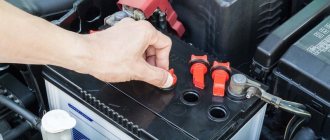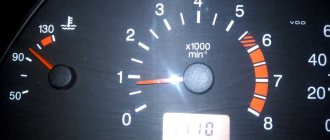From time to time, even maintenance-free and expensive battery models have to be connected to a mains charger. Such an operation cannot be avoided when the car has been sitting in a garage for a long time or has been operated at low engine speeds.
Regardless of the cause of the discharge, many motorists try to replenish electricity without disconnecting the battery from the vehicle’s on-board network. Whether such an operation can be carried out safely and why many vehicle owners use this method will be discussed in detail below.
Is it possible to charge a battery without removing the terminals?
Rechargeable batteries have been used in cars for over 100 years. During this time, car owners became convinced from personal experience that it is possible to charge the battery without disconnecting it from the on-board electrical system.
Many motorists claim that restoring charge using this method is completely safe, but some drivers have encountered serious problems with the car’s electrical equipment.
Is such charging possible?
The ability to charge batteries from a network charger without disconnecting from the vehicle's power supply system is not surprising. Almost all electrical appliances of this type are equipped with crocodile clips, which can be easily connected over the terminals.
It is enough to connect the device correctly (observing the polarity), turn on the device to a 220 V network, and the charging process will be carried out in standard mode. To increase the efficiency of the charger, you must turn off the ignition.
Even not very powerful electronic devices operating during the charging process can significantly increase the period of time required to completely restore the battery.
Unfortunately, devices such as radios and alarms are constantly connected to the car’s on-board network, so completely disabling them can cause significant difficulties.
You will have to put up with such a “standby” load, despite the presence of a significant increase in the time for battery recovery. Otherwise, you will need to disconnect one or both terminals from the battery.
Why you shouldn’t charge like this and what is the danger
As mentioned above, when the charger is connected to the battery without disconnecting the terminals, current from the electrical appliance can flow to electricity consumers operating in standby mode.
If the output voltage of the charging device does not exceed 14.7 Volts, then you should not be afraid for the safety of the equipment. Some chargers can generate voltages significantly higher than this value, which can cause damage to devices that work in the car all the time.
The presence of constantly switched on devices will significantly increase the load on the memory, which is also an undesirable point. For the same reason, the duration of battery charge restoration will increase, so if it is necessary to carry out this operation with minimal time, it is better to disconnect the battery from the vehicle’s on-board system.
Safety precautions when charging a battery without removing the terminals
Only from the outside, the charging procedure seems simple, since it does not require any special actions from the car owner. In reality, charging a battery without disconnecting the terminals is far from a simple process that requires control. When charging in this way, the following safety precautions should be observed:
- the charging station is connected to the network after connecting the terminals to the battery terminals;
- upon completion of the process, the terminals from the battery are initially disconnected, and only then the charging station is turned off.
Compliance with the following operations in the specified sequence will avoid overvoltage at the output of the charging station when it is turned on and off:
- you must connect the charger starting with the “positive” wire;
- disconnect - starting from the “negative” terminal;
- prevent any of the car's electrical consumers from turning on;
- prevent contact of exposed parts of the charging wires with the car body or ground;
- Choose a ventilated area to charge the battery;
- exercise control over the charging procedure.
You can charge the battery without disconnecting it from the car only if you follow safety measures and have 100% confidence in the output parameters of the charging station.
Why drivers don't like to disconnect the battery from the network
Many drivers do not like to disconnect the battery from the network. There may be several reasons for this decision:
- Laziness.
- If you turn off the power to the vehicle's on-board system, the settings in many devices that are not equipped with a backup power source can be completely reset. For example, the time in a radio may be lost if the battery installed on the board of this device can no longer cope with autonomously supplying the device with electricity.
- Many drivers are in no hurry to disconnect the terminals again due to possible breakdowns of these elements. According to statistics, when removing and connecting connecting elements, failure of parts occurs much more often than when charging the battery without removing it from the car.
- Disconnecting and reconnecting the terminals may result in insufficient electrical contact. In such a situation, an electric arc may form, which will melt the battery leads and terminals. Many drivers, precisely because of the possible failure of the connecting elements, try to charge the battery connected to the on-board system of the car.
The listed reasons for the reluctance to disconnect the battery are quite convincing, therefore, even despite the possible risks, car owners try to restore the battery charge using this method.
Safety precautions when charging the battery
The key to success in absolutely all endeavors is compliance with safety measures. And charging the battery in this regard is no exception to the rule, requiring strict compliance with the following conditions:
- It is imperative to wipe the terminals and other surfaces of the battery with a dry cloth, since they must be dry and the gas channels must be open.
- If there is a deficiency of electrolyte, it must be replenished by adding distillate or using a device for automatic voltage support if the battery design does not provide a topping function. As for the density of the working fluid, it should correspond to 1.27 g/cm3 and 1.25 g/cm3.
- Do not smoke or light matches near the battery, as this may cause a fire.
- It is not allowed to charge the battery directly from the outlet, because instead you need to use a special device, and not a homemade one, but a factory one.
- Exceeding the electrolyte temperature of 45 degrees is a reason to pause the charging process, allowing time for cooling.
- The DC voltage should fluctuate in the range from 12.6 to 12.7 V, although it must be measured only a few hours after the internal combustion engine has completely stopped.
In case of prolonged inactivity, it is recommended to charge the car battery in the standard way, using boosters (starting devices) only in case of emergency.
Based on these considerations, it is strongly recommended to fully charge the vehicle before storing it for long periods of time.
In what case is charging with terminals allowed?
In all cases where the potential danger from disconnecting the terminals from the battery is greater than the likelihood of damage to the equipment from connecting the charger without performing this procedure, it is recommended to connect the DC source without removing the connecting elements from the battery.
If, after disconnecting the terminals from the battery, their further use is impossible, then it is also more advisable to connect charging without disconnecting the wires from the battery.
For example, if there are cracks in the connecting element, such an operation can lead to destruction of the metal. In the absence of spare parts, such a breakdown may lead to the fact that it will no longer be possible to start the engine and, accordingly, operation of the machine will be impossible.
How to charge a battery without removing the terminals
If you decide not to remove the battery from the car and charge the battery without disconnecting the terminals, then this work should be completed without errors. First of all, you need to turn off the ignition, because a working dashboard, ignition system and other devices will consume a significant amount of electricity.
Next, connect the charger. The device should be de-energized if it was previously turned on. Then you need to determine where the positive terminal of the battery is. A red clamp should be connected to it. Accordingly, the black “crocodile” should be connected to the negative terminal of the battery.
At the next stage, the charger is connected to a 220 Volt network. If no errors were made, then immediately after activating the charging mode, the voltage of the required values will begin to be supplied to the battery terminals.
If an automatic device is used, no further action is required. When connecting a device with the ability to adjust the current, it is recommended to set the value of this parameter equal to 10% of the battery capacity.
Is it possible to charge a battery in the cold?
If there is nowhere to go, then you have to charge the battery even at critically low temperatures. The success of the result in this case will directly depend on the location of the battery, which is usually located under the hood, in the trunk, or has an external mount. And most often, motorists have to resort to all sorts of tricks to restore the battery as quickly as possible: heating the house near the radiators and covering the car with tarps and blankets.
In case of prolonged inactivity, it is recommended to charge the car battery in the standard way.
Precautionary measures
When working with electric current, safety comes first. For this reason, it is prohibited to perform this operation in a damp room. Failure to comply with this requirement may result in electric shock or damage to the charger.
Modern battery charging devices are well protected from polarity reversal. If the terminals are connected incorrectly, the fuse will blow, but the main circuit should remain unaffected.
It is not recommended to check the functionality of the safety elements, so you should be careful when connecting the wires coming from the charger to the battery.
All electrical contacts must be in perfect working order. The presence of sparks in the immediate vicinity of flammable substances can result in a fire.
Still have questions or have something to add? Then write to us about it in the comments, this will make the material more useful, complete and accurate.
Features of the car battery charging process
There are certain rules for charging batteries, compliance with which is considered a guarantee of safety, both for the motorist and the vehicle itself. According to them:
- To replenish the battery charge, it is recommended to partially dismantle it (negative terminal).
- The charge must be carried out in non-residential premises (garage, outbuildings, etc.).
It is important to remember that in cold weather the battery takes a charge much worse and professionals advise performing the procedure at a temperature range from 0 to +25 degrees Celsius.
And it is for this reason that in winter the battery restores capacity much worse directly during a trip, since the electrolyte does not have time to warm up.
- Directly during charging, harmful volatile substances are released. In addition, there is a risk of electric shock, so it is better to immediately remove rings, watches, bracelets and other metal jewelry from your hands.
If charging is carried out under conditions that do not involve removing the battery, which happens quite often, then the motorist will have to use a special device that provides reliable protection of the battery from damage.
Before starting work, all units must be turned off, since it is necessary to unload the battery as much as possible.
And if this is the case in winter, then the cooled battery must be moved for some time to a warm room and only then resort to manipulation with it.











